|
Report from
Europe
Climate change debate threatens to tip European
hardwood market over the edge
Headline figures for sawn hardwood consumption in
Europe show that demand has been flat for the last decade.
However, these figures obscure major underlying changes
in the European market.
This was clear from presentations and discussion during
the International Hardwood Conference (IHC) in Berlin
during November, an event co-organised by the European
Organisation of Sawmill Industries (EOS), the European
Timber Trade Federation (ETTF) and German Sawmill
and Wood Industries Association (DeSH).
There was a widespread view that new opportunities are
emerging, particularly driven by strong political and
emerging consumer interest in carbon mitigation and other
environmental concerns. However, it also became
apparent that other factors are undermining the ability of
the hardwood sector to respond to these opportunities.
The European hardwood market has become too narrowly
focused on a single species, oak, and there has been
insufficient focus on driving demand for and adding value
to other species.
Lack of investment in hardwood market development in
Europe has contributed to a large proportion of logs being
exported, particularly to China, a market which has lately
become very volatile.
Supply side problems are also arising as drought and pest
infestations in Europe have led to large volumes of lowquality
hardwood being placed on the market contributing
to falling prices for low grade lumber and by-products
such as chips, sawdust and bark.
There is also uncertainty over long term supply security.
Lack of consistent and harmonised inventory data across
Europe, combined with resource changes due to climate
change, have made projections of future supplies less
reliable.
In retrospect too, the almost exclusive focus on
certification in environmental communication may have
been a distraction from pressing environmental
imperatives in the hardwood sector that are not addressed
in existing certification frameworks.
These imperatives include the need to:
ensure that consumers buy the full range of
hardwood species and grades that the forest can
produce sustainably;
promote efficient processing and use to minimise
waste and maximise yield and value;
provide transparent data on the likely long-term
availability of different hardwood species;
respond effectively to changes in the resource due
to climate and other environmental impacts and
past management decisions (and failures);
remove illegal wood from hardwood supply
chains while promoting market access for legal
operators (both large and small); and
better demonstrate and exploit the carbon
mitigation potential of hardwood products.
Eastward shift in European hardwood consumption
According to data presented to IHC by Rupert Oliver,
Trade Analyst to the FLEGT IMM, the ITTO project
supported by the EU, EU-wide sawn hardwood
consumption was around 9.98 million m3 in 2018, 3%
more than in 2017. EU sawn hardwood consumption was
projected to have fallen back again to around the 2017
level in 2019.
Despite these minor ups and downs, overall sawn
hardwood consumption in the EU in the 2017-2019 period
remained firmly within the narrow band of 9.5 to 10.5
million m3 per year prevailing since 2009 and well down
on figures closer to 15.0 million m3 typical before the
financial crises.
Underlying these recent trends, said Mr Oliver, was
reasonably robust, if unexciting, growth in EU GDP and
construction in 2017-2018 and the first half of 2019.
However, economic uncertainty contributed to slowing
sawn hardwood trade in the second half of 2019.
Mr Oliver noted that the latest data from the joinery sector
shows that wood generally was holding its own against
other materials in doors and window manufacturing,
although much of this benefit may have accrued to
softwoods rather than hardwoods.
Mr Oliver said that EU wood furniture manufacturers are
continuing to maintain their dominance of domestic
markets and holding their own against imports. While
there is some weakness in EU wood furniture production
in western Europe, this is offset by a rise in Eastern
Europe.
Mr Oliver¡¯s data showed that per capita sawn hardwood
consumption in western European countries remains low,
typically less than 20 litres per year, and the trend is either
flat or sliding downwards.
In contrast, per capita sawn hardwood consumption is
generally rising in eastern Europe and already exceeds 100
litres per year in the Baltic States and is approaching 60
litres per year in Romania.
Mr. Oliver estimated that EU imports of sawn hardwood
from outside the region were around 2.2 million cubic
meters in 2019, very similar to the level in 2018,
maintaining the gains made compared to 2017, but still
down on imports of 2.4 million m3 in 2015 and 2016, and
only half of the level of before the financial crises (Chart
1).
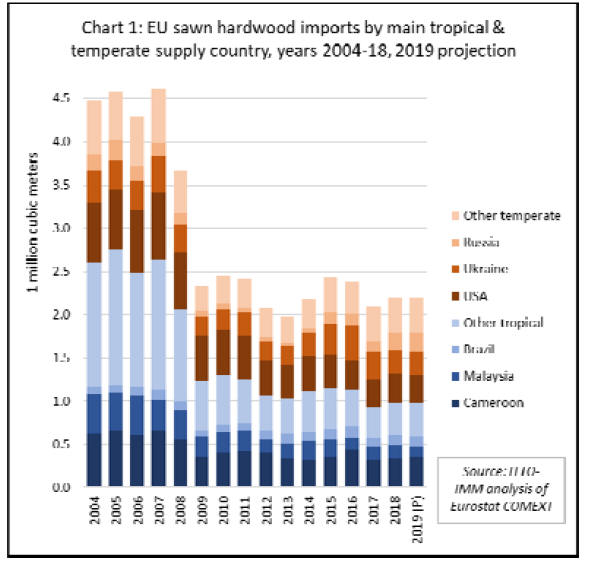
Mr Oliver noted that eastward shift in manufacturing in
Europe has been linked to a partial shift towards East
European and CIS hardwood suppliers in recent years,
with most growth in EU sawn hardwood imports coming
from Ukraine and Bosnia in 2016 and 2017, and Russia
and Serbia in 2018 and 2019.
According to Mr Oliver, total imports of tropical
sawnwood are projected to be 980,000 m3 in 2019,
marginally down from 993,000 m3 in 2018. Imports from
Cameroon and Brazil recovered some ground in 2019,
helping to offset a significant fall in imports from
Malaysia (Chart 2).
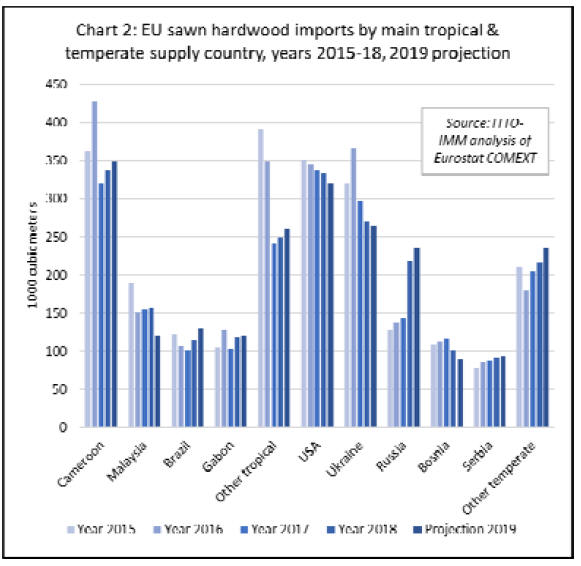
Expanding scope of TLAS and due diligence
regulations in tropical trade
Mr Oliver also commented on the evolving situation in
relation to legality verification, due diligence regulations
and certification in the international tropical hardwood
trade.
He highlighted the considerable scope of efforts to
develop Timber Legality Assurance Systems (TLAS) in
tropical countries, a process encouraged by the EU¡¯s
FLEGT Action Plan.
According to Mr Oliver, tropical countries that are either
already issuing FLEGT licences or in the process of
implementing a FLEGT licensing system accounted for
57% of global the value of trade in tropical wood and
wood furniture products in 2019, up from 52% in 2018
(Chart 3).

The rising share of FLEGT partner countries in tropical
trade last year was driven mainly by a sharp rise in exports
by Vietnam, a country which has set an initial objective of
establishing a FLEGT licensing system by the end of 2020
(although this plan is acknowledged to be ambitious and
time scales and activities are likely to be adjusted with
experience).
The work by tropical countries to implement TLAS is
mirrored by the wide range of countries that have
introduced regulatory measures requiring legality due
diligence for timber products in trade. According to Mr
Oliver, in 2019 around 70% of the total global value of
tropical wood and wood furniture trade is imported by
countries implementing such legislation, including the US
(28%), EU (15%), Japan (14%), South Korea (6%), and
Vietnam (3%) (Chart 4).
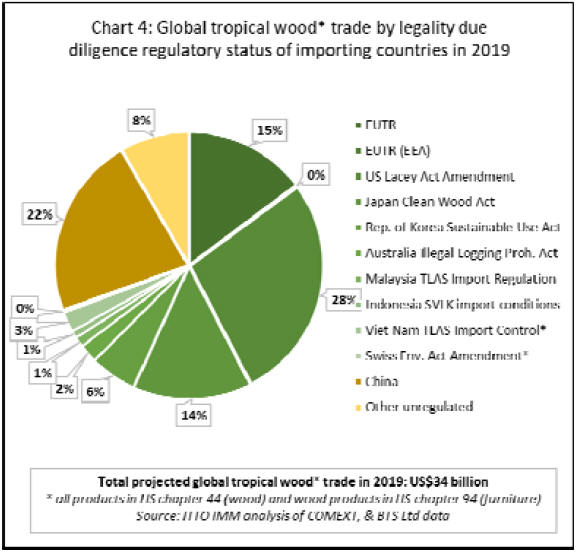
Mr Oliver said the widespread evolution of TLAS in
tropical timber supplying countries contrasts with the
implementation of forest certification. Analysis of data
from FSC and PEFC suggests that the total area of forest
certified by these schemes worldwide actually declined for
the first time in 2018.
Although FSC and PEFC both reported either stable, or a
slight increase in their own certified forest area during the
year, this was only because of a rise in the area dual
certified to both schemes (Chart 5).
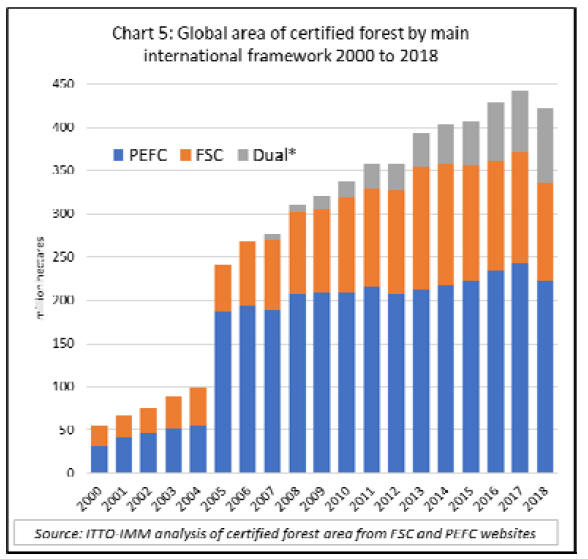
According to Mr Oliver, closer analysis of the data reveals
that most new certificates issued in recent years have been
for large state-owned and industry managed lands in
temperate and boreal regions, particularly in Russia.
Tropical countries and small non-industrial operators
remain seriously under-represented amongst certified
forest areas (Chart 6).
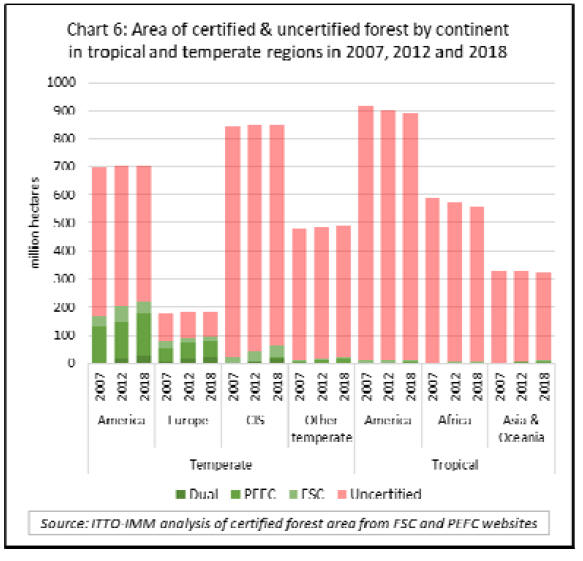
Certification necessary to overcome market
prejudices: a widespread view
While tropical countries are making headway to
implement TLAS systems, tropical wood promotion
activities in the EU is remains heavily oriented towards
certified products.
There is a strong view in parts of the EU timber trade and
industry that the market is so prejudiced against tropical
timber that nothing short of assurance of full conformance
to FSC and/or PEFC certification will overcome this bias
(and even this may not be enough for some influential
European specifiers and buyers).
Although not said explicitly, this was an underlying
narrative behind the presentation to IHC by Mr. Benoît
Jobb¨¦-Duval, Managing Director of the International
Tropical Timber Technical Association (ATIBT).
Mr. Jobb¨¦-Duval provided an update on two years of
progress to implement the Fair & Precious (F&P) ¡°verified
sustainable¡± tropical timber branding campaign in Europe.
This campaign, which ATIBT is implementing in
cooperation with various agencies including STTC, FAO,
European timber associations (including the European
TTF and national associations in Belgium, France,
Germany, UK, Fedustria), promotes FSC and PEFC
certified tropical timber.
The key message of the campaign, and the 10
commitments made by organisations adopting the brand, is
that FSC and PEFC certified forest operations directly
contribute to the delivery of the UN Sustainable
Development Goals in tropical countries.
M.r Jobb¨¦-Duval noted that three separate F&P
communication campaigns have been launched targeting
15,000 architects, specifiers, and potential buyers of
tropical timber, covering France, UK, Germany, Italy,
Spain and the Netherlands. Seventy-seven press articles
have been published so far reaching a total audience of 1.2
million.
A new F&P website (https://www.fair-and-precious.org)
was launched in October 2019, and a series of press trips
are planned in certified forest concessions. Social media
campaigns are underway through Instagram and Linked
In. Seventeen organisations are now F&P partners and the
number is gradually rising.
In France, said Mr. Jobb¨¦-Duval, a successful partnership
has been formed between F&P and the national railway
operator SNCF that now acknowledges the environmental
benefits of certified tropical timber and actively promotes
its wider use in the French rail sector.
ATIBT has also contributed to efforts, alongside STTC,
and the Danish offices of various organisations including
WWF and FSC, to rectify an effective ban on all tropical
timber in products certified by Nordic Swan, the official
ecolabel of the Nordic countries.
The label can be voluntarily applied to products in 60
categories groups, the most relevant for tropical timber
being furniture, outdoor furniture and playground fittings,
construction and façade panels, and windows and exterior
doors.
Mr. Jobb¨¦-Duval said that besides insisting that all timber
products bearing the Ecolabel were 70% FSC or PEFC
certified, with the remainder FSC controlled wood or from
PEFC controlled sources, Nordic Swan has drawn up an
82-strong list of species, dominated by tropical wood, that
it would not cover irrespective of whether or not certified.
As well as many lesser-known species, these included
many commercial species widely available and sold in
Scandinavia and the rest of Europe. Among them are ip¨¦,
doussie, jatoba, movingui and okoum¨¦.
Qualifications for being put on the prohibited list were
CITES listing, and inclusion on the IUCN red list
(categorized as critically endangered (CR)), endangered
(EN), vulnerable (VU) and relevant species as Near
Threatened (NT).
The decision to ban all these species from use in labelled
products takes no account of the fact that species listed in
CITES Appendices are not prohibited from exploitation
and sustainable use is often the best form of protection.
Mr. Benoît Jobb¨¦-Duval reported that a decision on this
policy is still pending by Nordic Swan (the ¡°Forestry
Requirements¡± for the label reported on the Nordic Swan
website in mid-January 2020 continue to include over 80
species of mainly tropical timber prohibited from use in
labelled products).
Deteriorating market and supply challenges for
European hardwood
The market situation for German hardwoods was
described at IHC by Steffen Rathke, Vice President of
DeSH who said that both domestic and export market
demand deteriorated in the second half of 2019, partly a
response to responding to mounting economic uncertainty
in Europe and China, the main export market.
Mr. Rathke also highlighted that raw material availability
is becoming more challenging in the hardwood sector with
pests and drought having an increasing impact. Mills are
having to cut back on production of beech because of
severe damage to logs during lengthy periods of drought in
recent years. Although the freshly harvested beech logs
often appear unblemished on the outside, the timber
contains a lot of defect and the yield of higher-grade
lumber is negligible.
Referring to a previous period when the export market for
European beech logs was severely undermined by
shipment of a lot of low quality (in this instance stormthrown)
beech, Mr. Rathke said that ¡°it is has taken 15
years to get the beech market back in China, but now
again we are seeing more of these lower quality being sent
to China and we could lose this market again¡±.
Mr. Rathke also expressed concern about the possibility of
a similar fate for oak with a rising incidence of worm
holes, which cannot be detected when logs are inspected in
the forest, also caused by drier conditions.
¡°Our trees are under stress¡±, concluded Mr Rathke, ¡°the
industry needs to do more to help forest owners, to bring
out the dead wood out, to replant and re-establish the
forest resource¡±.
A similar narrative emerged from a review of the wider
market for European hardwoods delivered to IHC by
Maria Kiefer-Polz, EOS Vice President for Hardwood.
She emphasised the rising impact of drought, pest and
disease increasing hardwood forest mortality and leading
to rising proportion of logs of lower grade being placed on
market and contributing in turn to a significant fall in
prices for chips, sawdust and bark, undermining the
profitability of hardwood sawmills.
There has also been a decrease in demand and prices for
packaging wood in parts of Europe due to a large increase
in low grade softwood on the market following a major
bark beetle infestation.
Ms. Kiefer-Polz said that the pressure on supply of
European oak eased during 2019 in response to cooling
demand both in Asia and Europe. Although prices for
higher grades of European oak logs had remained
reasonably stable, prices for lower quality oak logs were
down around 15% during the year. Longer term supply
problems are expected with rising oak mortality in the face
of drought.
European beech prices were also easing in 2019, with log
prices down around 15% due to lower log exports,
particularly to China. Demand for beech sawnwood is also
slowing in China. French beech sawmills are suffering
from falling prices in the context of rising raw material
availability and declining export demand.
Drought has meant there are now 700,000 m3 of dead
beech trees in Eastern France.
European ash log prices have remained high, benefitting
for some extent from this species popularity as a cheaper
alternative to oak. There has been particularly strong
demand for French ash logs in Viet Nam.
However, ash dieback is now hitting the European ash
resource hard and led to a rise in production which is
expected to be short-lived.
In Romania, according to Ms. Kiefer-Polz, there has been
falling export demand in China, North Africa and the
Middle East, traditionally the major markets for Romanian
sawn hardwood. Romania¡¯s domestic furniture industry is
also declining and consuming less hardwood, while
Romania¡¯s imports of furniture are rising.
Prices for Romanian sawn hardwood are falling and
warehouse stocks were rising in the second half of 2019.
Romanian sawn hardwood production is being curtailed
and is expected to be down up to 15% overall in 2019.
The whole wood sector in Romania is suffering from lack
of access to finance and low levels of investment.
The market situation of European hardwoods is made
more challenging by lack of reliable data on the resource
and understanding of the changing resource dynamics as
the climate changes. This issue was highlighted at IHC in
a presentation by Gert-Jan Nabuurs, Professor at the
Wageningen University and lead scientist for European
forests.
Surprisingly, given the long tradition of systematic forest
management in Europe and widespread perception of a
stable well-managed resource, Professor Nabuurs
commented that ¡°We know very little about hardwood
stocks, increment, and diameters [in Europe]. Data
gathering needs to improve. EU member states are not
sufficiently open with national forest inventory data and
inventory methodologies are inconsistent between
countries¡±.
This in turn had contributed to a situation where ¡°the
hardwood processing sector is not ready for the challenges
coming at us; climate change, matching regional demandsupply,
and fragmented ownership. The hardwood sector
needs much stronger collaboration between forest owners
and industry and much greater investment in forest
resources¡±.
On the changing composition of the European hardwood
forest, Professor Nabuurs suggested that ¡°there will be
more beech, but even this species is suffering. We hardly
know how fast the ash decline is taking place. Overall
there are some indications that we are eating up quality
[hardwood] stocks¡±.
US hardwood struggles in face of China trade dispute
The US hardwood industry is also facing challenges,
though for different reasons, according to American
Hardwood Export Council (AHEC) Executive Director
Mike Snow. From 2009 to 2017, US hardwood exports to
China had ¡®exploded¡¯. By 2018, one out of every four
boards of graded hardwood lumber produced in the United
States was destined for China.
However, this left the sector especially vulnerable to the
on-going US-China trade dispute. In fact, since the dispute
started, American hardwood sales lost in China have
exceeded total US hardwood exports to Europe and the
rest of Asia put together.
In the first eleven months of 2019, US sawn hardwood
exports to China were down 40%, with red oak and ash
each falling 38%, and white oak down 45%. China is not a
market that can be easily replaced. The loss of export sales
has been ¡°absolutely devastating for the industry¡± said Mr
Snow.
Mr Snow noted that US hardwood exports were hit
particularly hard by China¡¯s immediate reaction to the
trade dispute.
¡°At the same time as imposing a 10% tariff on US
imports, China allowed the RMB to devalue, effectively
increasing their cost still further,¡± said Mr. Snow.
While the only real solution, said Mr. Snow, was
resolution of the trade dispute, he added that the US
hardwood industry needs also to invest more in domestic
market promotion. US domestic consumption of hardwood
is driven by industrial applications, such as packaging and
pallets, rig mats used in the oil and gas industry, and
railroad ties, which collectively account for almost 60% of
volume. Although volumes are large in these sectors,
profitability is low.
Despite the current challenges for US hardwood in China,
caused by the trade dispute, and signs that the wider
Chinese economy is slowing, Mr. Snow suggested that this
country still offered significant opportunities for the
hardwood sector.
¡°China still has major hardwood growth potential, with
development of its western provinces and huge investment
in its belt and road programme, in particular, set to
increase its consumption still further,¡± he said. ¡°But at the
same time, there¡¯s realisation in the US hardwood sector
that it must diversify exports ¨C and grow its domestic
market. It can¡¯t afford to put all its eggs in the China
basket.¡±
Major focus on American red oak promotion in Europe
David Venables, AHEC Europe Director, highlighted that
the sharp downturn in US exports of hardwoods to China
has important implications for the market development of
American hardwoods in Europe. Specifically, it has
greatly increased availability of red oak, a species which is
largest single component of the US hardwood forest and
which previously dominated exports to China.
American exporters now need a new outlet for red oak
which traditionally has not been favoured in Europe.
Europeans have always tended to favour white oak which
closely matches the European oak familiar to European
manufacturers.
Mr. Venables observed that in recent years there has been
strong demand for European and American white oak
while supplies have come under pressure, pushing prices
higher. The market has been looking for more options,
initially turning to ash as the grain and colour is similar
and availability has been high in the short term, due to
dieback in Europe and the Emerald Ash Borer outbreak in
America.
Red oak provides another option, particularly as prices are
currently much lower than for white oak. However, Mr.
Venables noted that amongst European importers and
manufacturers there has been a negative attitude to red oak
with questions raised over its colour, performance and
durability.
Mr. Venables said that this view stems largely from lack
of knowledge, experience and familiarity with red oak in
Europe. However, AHEC has found, through regular
contacts with the European design community, that they
are often very responsive to red oak¡¯s appearance. Those
manufacturers that can be persuaded to use red oak have
come quickly to appreciate its strong technical
characteristics.
AHEC¡¯s strategy for red oak aims to supplement, but not
replace, the existing demand for white oak in Europe. The
main target group is designers, building on their evident
interest in the wood, but also involves efforts to educate
and inform European manufacturers and importers of the
opportunity offered from increased sales and use of red
oak.
Testing has also been undertaken to better assess and
document the technical performance of red oak, to
demonstrate that it is at least as good as other oaks, and to
highlight its versatility, especially on finishes. There is
also a major focus on red oak¡¯s vast resource base,
consistent supply, and sustainability.
M.r Venables said that throughout 1919 and 2020 AHEC
is engaged in multiple red oak design and building projects
across Europe to generate a constant flow of publicity.
These are being linked with targeted online and social
media campaigns.
Meanwhile, AHEC continues to development work on
new hardwood applications in Europe. AHEC has worked
with specifiers and designers on hardwood projects,
including the world¡¯s first cross laminated hardwood
building, a cancer care centre near Manchester in the UK
built with a core structure of American tulipwood CLT
and clad with thermo-treated tulipwood.
Mr. Venables also described the range of tools AHEC has
developed to demonstrate and promote US hardwoods¡¯
environmental credentials. These include an interactive
map showing forest growth and timber harvest, a life cycle
analysis (LCA) tool for US hardwood species and the
American Hardwood Environmental Profile (AHEP),
which details the carbon and wider environmental impacts
of hardwood consignments shipped anywhere in the
world.
In all these tools, emphasis is placed on providing easy
access to data individually tailored for all commercially
available American hardwood species. According to Mr.
Venables, this helps ¡°avoid too much focus on just a
narrow range of hardwood types. Our resource cannot be
sustainably managed unless we encourage use of the
whole portfolio of species¡±.
Mr. Venables emphasised that ¡°in the hardwood sector, we
have one of the world¡¯s the most sustainable materials, a
fact not yet widely recognised. We need to broaden the
discussion away from just certification and to innovate in
our communication.
For technical reasons, we can¡¯t offer certified volume, so
instead we have developed an interactive map, making US
forest inventory data accessible to end users and
specifiers¡±.
He went on, ¡°we have also reviewed and updated the
Seneca Creek study, first commissioned by AHEC in
2008, which demonstrates that American hardwood forests
are sustainably managed and that there is a negligible risk,
certainly much less than 1%, of any illegal wood entering
the US hardwood supply chain. Through our LCA work,
we prove to specifiers and our customers that we are
supplying not only a technically superior material, but also
a carbon store¡±.
North
|